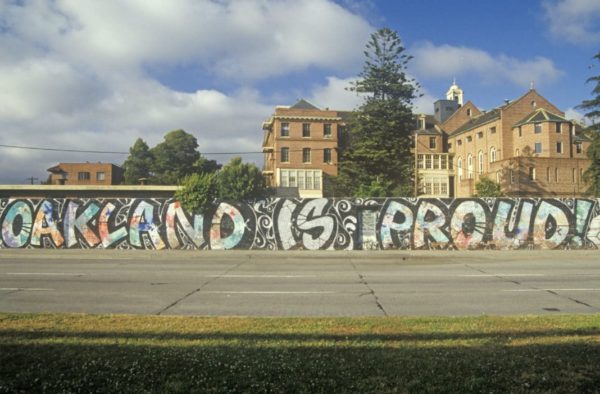
Graffiti on the streets of Oakland, California. Credit: Getty Images
The debate over gentrification is alive and well, with communities across the country discovering that the influx of new neighbors — ones that once fled cities like Houston, Los Angeles, New York, Oakland and more — is bringing more than shiny new Starbucks to their neighborhoods, namely, rising rents and higher incidences of 911 calls on longtime residents.
White flight has long been seen as a contributing factor to the creation of racially segregated communities, but the motivation behind whites leaving urban areas for suburbs has often been debated, with some arguing that whites were driven by race as well as a simple desire to live in better neighborhoods. But a study from Indiana University Bloomington confirms what communities feeling the effects of that flight have long discussed, with sociologist Samuel Kye finding that, historically, white Americans have simply started fleeing their neighborhoods to other areas anytime a significant amount of nonwhite residents started moving in.
After “better” neighborhoods are established they become fiercely protected, with minorities unfortunately viewed as “outsiders” regardless of their own socioeconomic status. Younger white Americans however — most notably those in their 20s and 30s — are showing a different pattern, with many trading in the suburbs in favor of inner-city communities, although Kye was unable to confirm if this is a pattern that will hold long term.
For those that were left behind during earlier waves of white flight, the sudden interest in their communities has been bittersweet, to say the least. Enclaves of low-income communities typically contain cheaper real estate, and with a shortage of affordable housing across the United States, that property is enticing many back to areas once seen as “undesirable.”
It’s a scenario that for some is reminiscent of an ugly American tradition of pushing minorities out of spaces they were once pushed into — as seen in Tulsa’s Black Wall Street and elsewhere. Overt acts such as race riots have been replaced with more subtle means, as gentrifiers have started changing the landscape of communities across the country.
There’s another side to gentrification, one that has drawn scores to areas deemed “ghettos” in hopes of getting an urban experience or “black branding,” as it’s come to be called for those looking to market to white millennials. This tactic leverages economic and racial disparities in selling a neighborhood’s perceived “edge.”
It’s an odd occurrence documented by author and American University professor Derek S. Hyra in his 2017 book “Race, Class, and Politics in the Cappuccino City” when recounting a Washington fundraiser in which new residents described crime in the area as an amusing joke of sorts, writing, “They described neighborhood carjackings, shootings, and purse snatchings with laughter and jokes.” Hyra added, “It seemed that the neighborhood violence gave some newcomers … something interesting to talk about at parties.”
For other newcomers, it’s nothing more than a smart economic move that allows them to purchase land or rental space at a discounted rate, then move into a neighborhood with the intent to “fix it up.” In cities long left under-served and with limited resources, an influx of new dollars can result in positive changes to the community in the form of fresh landscaping, renovations and more, but it can come at the expense of longtime residents, who suddenly find themselves unable to afford neighborhoods they’ve lived in for years, a phenomenon that largely displaces Black and Latino residents.
With America already facing a housing crisis in the form of stunted home building and a shortage of available rental units, the hunt for affordable housing has become fierce in some markets — including the San Francisco Bay Area, which finds San Francisco listed as the fourth-most expensive city in the nation and San Francisco County as the most expensive in the state.
Even Silicon Valley residents have felt the pinch, making cities like Oakland, Richmond and even Vallejo more appealing to those that previously wouldn’t have been caught dead in places like West Oakland — despite its recent popularity in films like Marvel’s blockbuster hit “Black Panther.”
But the city that Oakland native and director Ryan Coogler featured in films like “Fruitvale Station” has been quietly shifting for over a decade, with longtime residents forced farther and farther away from the Bay Area — replaced by those able to afford rents that can top upward of over $3500 for a two-bedroom apartment in some areas.
As the Mercury News reported last year, “About half of Bay Area renters are considered economically burdened, spending over 30 percent of their paychecks on shelter. But the region’s record-setting housing prices are forcing high wage earners into the rental market, too. Real estate agents and researchers say wealthier clients in the Bay Area are choosing to rent because they can’t afford to buy.”
It’s an abrupt reversal from the period of white flight that once left cities like Oakland predominately black, with many minorities largely unable to follow thanks in part to redlining and unfair lending practices that essentially prevented them from accessing the same home loans granted to white home buyers.
Now those with the means to snap up housing are doing so, forcing others to compete for what’s left. Residents have found little relief from programs like Section 8, which is currently facing a bottleneck that officials fear may not be resolved until 2020 as desperate residents find themselves wait-listed for the program.
Those unable to afford — or find — comparable housing are simply moving farther out or leaving the state altogether. According to a 2017 poll from the Bay Area Council, 40 percent of residents are considering this route.
Dan Sawislak, executive director of Resources for Community Development paints the situation in Oakland starkly: “Oakland rents have skyrocketed. Working-class families have huge challenges finding a decent place they can afford.”
Unfortunately, Californians are not alone, with markets across the country facing similar crises in the form of shrinking housing. As a study from the National Low Income Housing Coalition found that “because of the shortage of affordable and available homes, many lower-income households spend more on housing than they can afford without sacrificing other necessities.”
And as the income gap continues to widen, the ability to pay rent on top of the rising cost of everything else has made it exceedingly difficult for minorities, in particular, to remain in areas they once called home.


